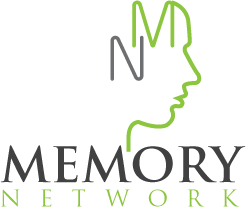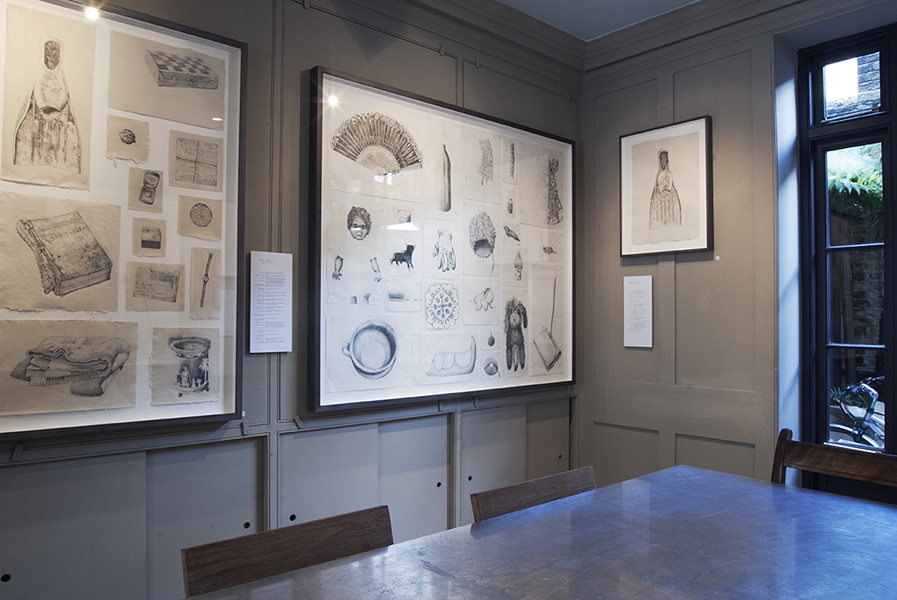Fay Ballard’s scrutiny, analysis and use of found objects from her father’s house following his death in April 2009 is crucial in her current creative practice, materials and methods. Ballard’s artistic practice is at the core of her understanding of who she is, as well as where she has come from. The death of a parent throws up many emotions, this is a complicated time of mixed emotions for many of us, as the past is seen as sliding away but memories can also be vivid. Ballard’s work is a moving contemplation on memory and personal loss, and its relationship to objects and photography.
Ballard examines and recreates the objects via large drawings placed in cabinets, and there is a sense of total immersion of the artist’s part in the creative process. Her intricate fine and beautiful drawings are at the same time sensitive and powerful, as for Ballard and the viewer things that could be inconsequential become symbolically immense, loaded with metaphor.
Ballard treasures her mother’s small delicate powder compact from an age gone by, and the intricacies of her drawing of this object testify to its importance. Ballard as a child was unable to discuss the death of her mother openly, it was as if all trace of her existence was extinguished, or hidden away. No doubt as a protective mechanism at the time, or because it seemed like an easier option compared to an extended grieving process, but as Freud said the return of the repressed is one possible outcome of such denial.
The powerful pencil drawing from a photo of Ballard as a small child with both parents Omen (i) 2013 is a poignant and tender piece and acts as a stilted narrative, or film still, as an ending but also as a beginning of an investigation of knowledge of her mother. This crucial reassessing of her childhood memories in recent years has permeated her practice. Children are able to accept almost any situation as normal, for Ballard actual knowledge of her mother came later. Ballard’s mother died when she was seven years old. Discovery of her mother came following her father’s death when she found some of her mother’s belongings in her father’s house.
Other objects from the same house also feature in her practice and can be linked to a sense of time passing, or even death, an ossifying lemon kept on her father’s mantle piece for over 30 years, the flipper from childhood holidays used later as a dusty doorstop. Time seemed to stop for Ballard’s father also after he lost his wife and mother of his children. As a very public figure, a space for private grieving may have seemed impossible.
Ballard’s search for a visual language is practical as well as conceptual, and challenges the ways in which art is produced, displayed and received. Ballard’s influences are aspects of biography and of experimental art practices using family photos, drawing and installation. Containers are also important, found objects as metaphors for memories kept under wraps, also as a place of safety for the future, hinting also at anthropology and Museum culture.
CONTEXTS
Women artists have successfully raised issues of identity and artistic practice, and Ballard’s work in its use of psycho- biography, creativity, memory, relationship to her mother and father, as well as her own identity as an artist and mother, can be linked to artists such as Louise Bourgeois and Tracey Emin who contribute to the increased interest and awareness of women’s psychic and social dynamic and agency, and encourage discourse about the personal and political, culture and the visual. Ballard’s fine drawings can also be linked to the intricacies of crochet or embroidery, traditional women’s craft activities. Ballard has appropriated methods of presentation that come from museology, for example the use of the vitrine and labeling as an integral part of the structure of the work, assembled from parts or fragments.
The status, meanings, construction and values attached to objects used within art practice, has been an issue discussed in relation to found and constructed artifacts since the artist Marcel Duchamp began his radical interventions at the beginnings of the twentieth century. Found objects surfaced as a source of inspiration and material in works of art for Duchamp, who began to invent art works from existing, manufactured, found objects. For Duchamp these objects were random, insignificant apart from the rhetoric of ideas and concepts. Ballard’s practice is part of this tradition and yet there is quirkiness in her exploration of objects, the personal associations for her are what drive the work, and there is also originality in her choice of use of materials and in their recreation.
The very notion of what memory is and how it functions is pertinent here, Roland Barthes in his important book Camera Lucida (1986) questions the relationship between photographs and memory, and challenges the norm by suggesting that photos are the memory, can take the place of memory, or recreate ideas of the past through the present. The idea of the self at the beginning of the twenty first century is perceived as generally fragmented and displaced, and identity is often formed within the realm of the imaginary where identity is explored. Narrative is a crucial part of Ballard’s exploration, as looking to the past and future is always in a sense a fiction. The notions of the desire to know via Freud are underlying theoretical readings; the daydreams of children are a place where fact and fiction merge.
‘THE OBJECT’ OBJECTIFIED
Collected and valued for historical or cultural interest, a found object corresponds to a memory, it becomes a symptom of use and part of personal history. In Ballard’s installation work created from drawings of objects, and from photographs, she is tracing back time to the memory attached to the designated object(s) that becomes an integrated part of the whole, and can be an important part of the process of the construction of underlying psychoanalytic meanings of her art works.
Desire in relation to objects manifests as a need or drive to be close to, or to own and collect certain objects. Objects can be described as parts or whole, as metonym and metaphor. A personal possession often has no obvious use or function, it is still a commodity, and it can be exchanged and valued. It has a value to the owner, which is difficult to measure in comparison to the value it is ascribed within a consumer society, where worth can be measured by exchange and use value. A simple (i.e. easily and inexpensively produced) object can take on an unreal or specific status in the life of an individual, and consequently can be directly related to subjectivity. This was ascertained as part of the analytic practice ‘Object Relations’ theory of the eminent therapist and writer Melanie Klein.
Klein’s analytic work privileges the important dyad of the relationship between the mother and child, as the mother is the first parent to form an emotional and physical bond with the infant, and Klein’s theories that privilege the ‘mother’ can be examined in the context of feminism in order to redress the balance. Similarly for Ballard, her relationship with her mother is the one that now occupies her psyche as looking for a female essence is part of her practice.
The psychic stages for the infant according to the analysis of Melanie Klein lead to a desire to preserve the mother from aggression and destructive instincts as part of Klein’s Object Relations based therapeutic analysis. Restorative fantasies form part of the stage and behaviour that resolves earlier ‘depressive anxiety’, and this is named ‘Reparation’. Klein’s theories contain an optimistic outlook in relation to reparation, viewed as a genuine expression of love for the mother as well as the increase in love for one’s good and real object goes a greater trust in one’s capacity to love and a lessening of the internal activity and paranoid anxiety of bad objects.
This process of reparation has since been emphasised in writing on art and creativity as it manifests by means of ‘creative labour’ on the part of an individual, most notably it has been discussed by Hanna Segal and Adrian Stokes. Stokes made a direct analogy between this “symbiotic relationship” between good and bad, part and whole objects, to the creative process involved in the production of an artwork.
DISRUPTION
Ballard’s practice can also be linked to the French feminist philosopher and psychoanalysist Julia Kristeva’s theories, whose ideas are crucial for women as she chooses to focus on femininity, motherhood (see her famous essay on the Renaissance artist ‘Motherhood according to Giovanni Bellini’: Columbia 1980), and sexual difference, and to an early stage in development, a time and space that she refers to as “The Semiotic”. This space is not inherently feminine, but for Kristeva the Semiotic is a pattern or play of forces present in language, but that have an effect on an infant (means ‘speechless’) before he or she can use language. Kristeva imagines the infant’s body as criss-crossed by a flow of ‘pulsations’ or drives which are chaotic and disorganised at this point.
The semiotic can be experienced as a kind of pulsional pressure within language itself, in tone, rhythm, the bodily and material qualities of language, but also in contradiction, meaningless, disruption, silence and absence. And so the semiotic is ‘the other’ of language but intimately entwined with it. Because it stems from the pre-Oedipal phase, it is bound up with the child’s contact with the mother’s body.
Creatively this semiotic space as described by Kristeva is fluid and multiform, a kind of pleasurable creative excess over precise meaning, and is opposed to all fixed transcendental or intellectual meanings and is more fluid, de-centered and polymorphous, also disruptive and revolutionary.
Kathy Kubicki
February 2014
Kathy Kubicki is Senior Lecturer in Photography at UCA Farnham, and Associate Lecturer at Central Saint Martin’s UAL. A founding editor of Photography & Culture, her critical writings have been widely published, for example, in Portfolio, Visual Resources, Art Review and Modern Painters. Her interviews with Shirin Neshat, Sophie Calle and others are included in Tate’s archive Audio Arts, and in the anthology Speaking of Art.

